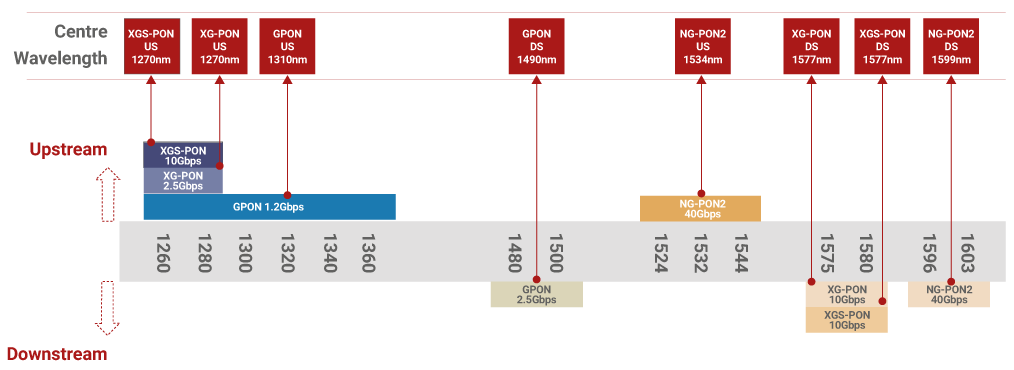What is PON
What is PON?
GPON
Gigabit Passive Optical Networks provides up to a 20km reach at speeds of up to 2.5Gbps downstream and 1.25Gbps upstream. QoS handles voice, video and data.
XG-PON
Compatible with GPON, XG-PON delivers 10Gbgs on the downstream speed and 2.5Gbps on upstream. A range of 20kms is again achievable, as is Quality of Service (QoS).
XGS-PON
XG Symmetric PON offers the same downstream speed as XG with 10Gbps but can match that on the upstream. Again it offers compatibility with GPON, a 20km range and Quality of Service (QoS).
NG-PON2
Also known as TWDM-PON, this recent addition uses 4 wavelengths broadcasting simultaneously to achieve 40Gbps on both the upstream and the downstream. It also supports 20kms of range, Quality of Service (QoS) and compatibility with GPON, XG-PON and XGS-PON.
Each Transmission Standard uses its own wavelength range which is what allows for compatibility. The below table graphic shows these and the potential for upload/download performance.

Why use passive PON networks?
Passive Optical Networks make use of Time Division Multiplexing (TDM) and WDM Technology (Wavelength Division Multiplexing) to designate bandwidths to each of the client connections from the providers connection.
The splitters (and multiplexers) allows for a greater density of end clients by letting them share the same physical medium – the optical fiber, without enabling inter client communications. There are many competing technologies on the market ranging from traditional standards such as GPON or EPON to the newest like XGS-PON or NG-PON2 that are pushing PON to the next level.
Traditionally PON has been asymmetrical, using a greater downstream bandwidth with a constant power signal from the central node (called the OLT), which then can be split for up to 128 end clients. The end client equipment (usually referred to an an ONU) then filters out only the frames relevant to each client and discards other frames. Upstream communications are emitted in bursts using Time Division Multiplexing to consolidate communications back into the OLT at the providers office.




